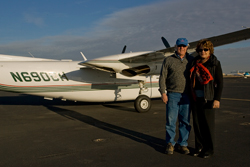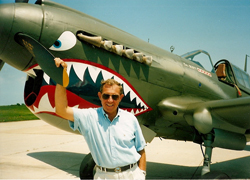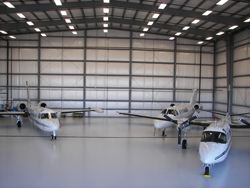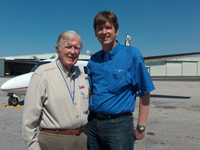Many Twin Commander owners volunteer their airplane, time, and piloting skills for humanitarian purposes such as Angel Flight medical transport for deserving patients. Jerry Severson of Bozeman, Montana, has flown such flights in the past, but he rates a recent trip he provided to Marine Corps Lance Cpl. Matthew Ryan Bradford and his mother, Debbie, as “the neatest thing I’ve ever done.”
The Bradfords are native Kentuckians and big fans of the University of Kentucky Wildcats, and the flight that Severson made on their behalf was from San Antonio to Lexington, Kentucky, to see a Wildcats basketball game. What made the flight so special was Bradford himself.
On January 18, 2007 Bradford was on patrol with the 2nd Battalion, 3rd Marine Division, near Haditha, Iraq, to clear an area of roadside bombs. He stepped on a hidden improvised incendiary device (IED), which exploded, severing his left leg and so severely injuring his right leg that it later had to be amputated. A piece of shrapnel destroyed his left eye and lodged in his brain, and his right eye suffered retinal damage, leaving him totally blind. He also suffered intestinal damage and a broken right hand.
Three years later he was up in the cockpit of Severson’s 690A, enjoying the ride and even handling the controls.
Bradford’s remarkable story revolves around his refusal to let his injuries rule his life. Instead, after being in a medically induced coma for 3 weeks and then recovering from his injuries for the next 18 months, Bradford has focused on continuing his career with the Marines—he hopes to work with injured soldiers returning from combat—and living a normal life.
For Bradford, who wears prosthetic legs, “normal” means riding personal watercraft, water skiing, rock climbing, surfing, scuba diving, and participating in marathons using a hand cycle. He’s also learned to fly fish, thanks to the Bozeman-based Warriors & Quiet Waters Foundation, Inc. The foundation invites wounded veterans from wars in Iraq, Iran, and Afghanistan to Montana for a six-day program of fly-fishing and recreation to provide “a respite from the rigors and stresses of war and from the treatment they have endured because of their injuries.”
Bradford was invited to participate in the program in 2009, and became the first blind alumnus.
During his visit his fondness for the Kentucky Wildcats became known, and a WQWF director arranged for Bradford and his mother to attend a game. Severson offered to fly his 690A to San Antonio to pick them up and fly them to Lexington, home of UK, for the game. They would stay the night so the Bradfords could see family and friends in Kentucky, and then Severson would return them to San Antonio the next day. Tom O’Connor, a retired navy captain from Bozeman, and his wife, Celia, accompanied Severson on the flight.
Bradford wanted to fly copilot on the trip to Lexington, which required removing his prosthetic legs to get into the right seat. During the flight he took the controls for a time. “He liked that,” Severson says.
Bradford has a keen sense of humor that his blindness and other injuries have not diminished. Severson saw it firsthand when Bradford said that his serving as copilot “gives new meaning to flying blind.” For the big game, he wore a prosthetic eye on the left side that was emblazoned with the Wildcats logo.
The trip to Lexington went well, as did the game—the Bradfords had excellent seats, Matt wore an ear set to listen to the play-by-lay, mother and son cheered wildly the entire game, and the Wildcats won in a buzzer-beater.
The return trip was into headwinds and deteriorating conditions. “It was crummy weather coming back into San Antonio,” Severson says. “I turned around and told Matt, ‘I can’t see a thing.’ And he said, ‘I can’t either.’”
“He is a remarkable young man,” Severson says of Bradford. “He doesn’t feel sorry for himself at all. He’s as positive as can be. I’m very fortunate to be able to fly, and it’s great to do something like this.”






